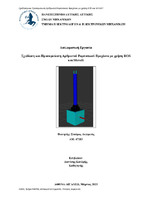| dc.contributor.advisor | Kandris, Dionisis | |
| dc.contributor.author | Αυγερινός, Σταύρος | |
| dc.date.accessioned | 2023-03-14T13:48:24Z | |
| dc.date.available | 2023-03-14T13:48:24Z | |
| dc.date.issued | 2023-03-10 | |
| dc.identifier.uri | https://polynoe.lib.uniwa.gr/xmlui/handle/11400/3911 | |
| dc.identifier.uri | http://dx.doi.org/10.26265/polynoe-3751 | |
| dc.description.abstract | Στη σύγχρονη κοινωνία τα ρομπότ αποτελούν μέρος της ζωής των ανθρώπων. Η παρούσα διπλωματική εργασία επικεντρώνεται στα ρομπότ σταθερής βάσης και ειδικότερα στους ρομποτικούς βραχίονες. Η αρχιτεκτονική, τα επιμέρους δομικά στοιχεία και τα λειτουργικά χαρακτηριστικά των ρομποτικών βραχιόνων περιγράφονται αναλυτικά. Στη συνέχεια περιγράφεται η διαδικασία που πραγματοποιήθηκε για τη προσομοίωση ενός αρθρωτού ρομποτικού βραχίονα, του πιο γνωστού τύπου ρομποτικού βραχίονα, με τη χρήση του ROS το οποίο χρησιμοποιείται εκτενώς για τον προγραμματισμό οποιουδήποτε ρομπότ και όχι μόνο. Στα κεφάλαια αυτά παρουσιάζεται πως δημιουργείται ένα ρομπότ στο περιβάλλον του ROS και τι χρειάζεται για να λειτουργήσει. Για αυτό γίνεται χρήση του URDF μέσω του οποίου δομείται το ρομπότ και είναι ένας οδηγός για άλλες λειτουργίες του ROS. Επιπρόσθετα επεξηγείται η χρήση του λογισμικού MoveIt για τον έλεγχο και την εποπτεία της κίνησης του ρομποτικού βραχίονα. Σε αυτό το πλαίσιο πραγματοποιείται η κινηματική ανάλυση του ρομποτικού βραχίονα που είναι αναγκαία προκειμένου το ρομπότ να ρυθμίζει τις αρθρώσεις του ώστε να προσεγγίζει με το άκρο του την επιθυμητή θέση στην οποία βρίσκεται ένα στοιχείο με το οποίο το ρομπότ πρέπει να αλληλεπιδράσει. | el |
| dc.format.extent | 175 | el |
| dc.language.iso | el | el |
| dc.publisher | Πανεπιστήμιο Δυτικής Αττικής | el |
| dc.rights | Αναφορά Δημιουργού - Μη Εμπορική Χρήση - Παρόμοια Διανομή 4.0 Διεθνές | * |
| dc.rights.uri | https://creativecommons.org/licenses/by-nc-sa/4.0/deed.el | * |
| dc.subject | Ρομποτικός βραχίονας | el |
| dc.subject | Ρομποτικές εφαρμογές | el |
| dc.subject | Τεχνητή νοημοσύνη | el |
| dc.subject | ROS | el |
| dc.subject | RViz | el |
| dc.subject | MoveIt Motion Planning Framework | el |
| dc.subject | PID controller | el |
| dc.subject | Κινηματική ανάλυση | el |
| dc.subject | Προσομοίωση ρομποτικού βραχίονα | el |
| dc.subject | Robot Operating System | el |
| dc.title | Σχεδίαση και προσομοίωση αρθρωτού ρομποτικού βραχίονα με χρήση ROS και MoveIt | el |
| dc.title.alternative | Design and simulation of an articulated robotic arm using ROS and MoveIt | el |
| dc.type | Διπλωματική εργασία | el |
| dc.contributor.committee | Koulouras, Grigorios | |
| dc.contributor.committee | Ζώης, Ηλίας | |
| dc.contributor.faculty | Σχολή Μηχανικών | el |
| dc.contributor.department | Τμήμα Ηλεκτρολόγων και Ηλεκτρονικών Μηχανικών | el |
| dc.description.abstracttranslated | In modern society robots are part of people’s lives. This thesis focuses on fixed base robots and in particular on robotic arms. The architecture, the individual structural elements and the functional characteristics of the robotic arms are described in detail. The following describes the procedure carried out to simulate an articulated robotic arm, the most well-known type of robotic arm, using
ROS which is extensively used for programming any robot and not only. These chapters show how a robot is created in the ROS environment and what it needs to work. This uses the URDF through which the robot is built and is a guide for other ROS functions. In addition, the use of the MoveIt software to control and supervise the movement of the robotic arm is explained. In this context, the kinematic analysis of the robotic arm is carried out, which is necessary for the robot to adjust its joints in order to approach with its end the desired position in which there is an element with which the robot must interact. | el |


